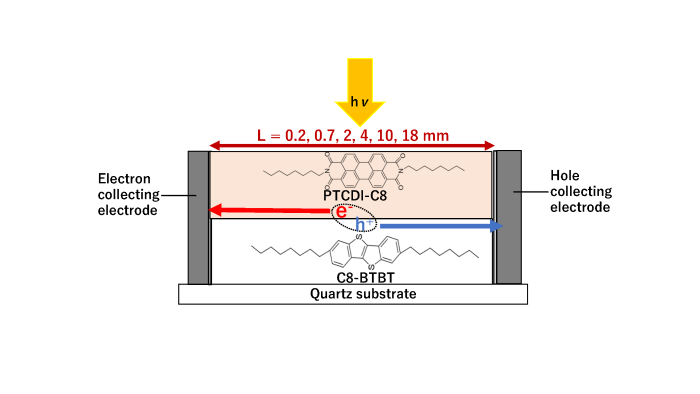2021.10.12
Lateral organic solar cell with centimeter long lateral junction
SOKENDAI Publication Grant for Research Papers program year: 2021
Functional Molecular Science Palassery Ithikkal Jaseela
分子科学コース
Photovoltaic behavior of centimeter-long lateral organic junctions
journal: Applied Physics Express 14, 094001 publish year: 2021
DOI: https://doi.org/10.35848/1882-0786/ac17d2

The photovoltaic behaviors of lateral cells with different lateral junction lengths from 0.2 mm to 18 mm were studied. Even a lateral cell with 18 mm long lateral junction was successfully operated with organic semiconductors having high mobility for carriers.
The ever-increasing energy demand due to the growing human population, the limited supply and price hike of the conventional energy sources have drawn attention to exploiting clean and sustainable energy. Among several alternative energy sources, solar energy is inexhaustible, economic, and can be utilized with minimal impact on the environment. Organic solar cells are a promising alternative to solve those energy issues. Organic semiconductors absorb light to form excitons (electron-hole pairs), which are then diffused to the interface between the donor and acceptor semiconductors to dissociate to free charge carriers. The thickness of conventional solar cells is limited to few nanometers due to the small diffusion length of excitons. Since the thickness of solar cells is of nanometer order, only a few wavelengths of the solar spectrum photons can be absorbed by the cell and convert to photocurrent and the rest of the spectrum are not utilized effectively. This limits the efficiency of solar cells. This can be overcome by the lateral junction solar cell in which the carriers are transported laterally and are collected by electrodes. Thus, unlimited layers can be stacked to absorb entire wavelength of solar spectrum. The lateral junction solar cell with high mobility organic semiconductors was already reported.
In this work, we study the distance dependence of the length of the lateral junction on the device performance. Very long diffusion lengths for electrons (4.7 mm) and holes (5.5 mm) were determined in this study. Surprisingly, even a lateral cell having a lateral junction of 18 mm showed clear photovoltaic behavior.
However, the lateral cells showed significantly small photocurrent compared to the conventional vertical one. It is due to the low exciton dissociation efficiency caused by the long insulating chains between donor and acceptor molecules. Thus, in order to solve this issue, we are now focusing on the addition of highly efficient carrier-generating donor and acceptor layers between these lateral transporting layers to improve the photocurrent generation.
Bibliographic information of awarded paper
- Title: Photovoltaic behavior of centimeter-long lateral organic junctions
- Authors: aseela Palassery Ithikkal, Adrien Girault, Mitsuru Kikuchi, Yusuke Yabara, Seiichiro Izawa, and Masahiro Hiramoto
- Journal Title: Applied Physics Express 14, 094001
- Publication Year: 2021
- DOI: https://doi.org/10.35848/1882-0786/ac17d2
Department of Functional Molecular Science Palassery Ithikkal Jaseela
